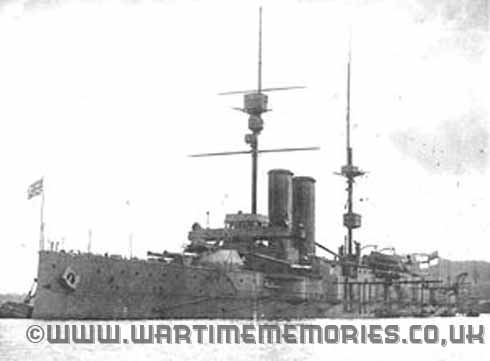1st July 1914 HMS Hibernia 
HMS Hibernia
HMS Hibernia was laid down at Devonport Dockyard on 6 January 1904, launched on 17 June 1905, and completed in December 1906. She was the last of the eight King Edward VII-class battleships to be completed.
HMS Hibernia was a King Edward VII-class pre-dreadnought battleship of Britain's Royal Navy. Like all ships of the class (apart from HMS King Edward VII) she was named after an important part of the British Empire, namely Ireland. Commissioned in early 1907, she served as the flagship of the Rear Admirals of firstly the Atlantic Fleet and then the Channel Fleet. When the latter fleet was reorganised to the Home Fleet, she was based at the Nore.
In 1912, Hibernia hosted trials in naval aviation with the temporary addition of a runway to her foredeck, and the first launch of an aircraft from a vessel underway was achieved from her in early May. Later in 1912, after her experiment with aviation was completed, she and her sister ships formed the 3rd Battle Squadron. The squadron was assigned to the Grand Fleet at the beginning of World War I, and served on the Northern Patrol. In 1915 she supported the Dardanelles Campaign and provided cover for the evacuation from the Gallipoli Peninsula. On returning to the United Kingdom she was again attached to the Grand Fleet before being transferred to Nore Command in May 1916, finishing the war as an accommodation ship. She was decommissioned in 1919 and scrapped in 1922.
World War I
Upon the outbreak of World War I, the 3rd Battle Squadron was assigned to the Grand Fleet and based at Rosyth. It was used to supplement the Grand Fleet's cruisers on the Northern Patrol, and Hibernia continued her service as Second Flagship of the squadron. On 2 November 1914, the squadron was detached to reinforce the Channel Fleet and was rebased at Portland. It returned to the Grand Fleet on 13 November 1914.
Hibernia served in the Grand Fleet until November 1915.[7] During sweeps by the fleet, she and her sister ships often steamed at the heads of divisions of the far more valuable dreadnoughts, where they could protect the dreadnoughts by watching for mines or by being the first to strike them.
In November 1915, a division of the 3rd Battle Squadron consisting of Hibernia (which served as flagship of the division commander, Rear-Admiral Sydney Fremantle) and battleships Zealandia, Russell, and Albemarle was detached for service in the Dardanelles Campaign. The ships departed Scapa Flow on 6 November 1915; Albemarle suffered heavy damage in a storm on the first night of the voyage and had to return for repairs, assisted by Hibernia and accompanied by Zealandia. Hibernia, Zealandia, and Russell then pressed on and arrived at the Dardanelles on 14 December 1915. Hibernia served as stand-by battleship at Kephalo and covered the evacuation of V and W Beaches at Cape Helles on 8 January 1916 and 9 January 1916. Among those serving aboard her during this time was Augustus Agar, later V.C. and famous for exploits against the Bolsheviks and as captain of heavy cruiser Dorsetshire in World War II. Later in January, Hibernia was stationed at Milo in case she was needed to cover an evacuation of the French force at Salonika. Before the end of January, Russell relieved her as divisional flagship, and Hibernia returned to the United Kingdom, being reassigned to the Grand Fleet upon arrival at Devonport Dockyard on 5 February 1916. She underwent a refit there in February and March 1916 before rejoining the Grand Fleet.
On 29 April 1916, the 3rd Battle Squadron was rebased at Sheerness, and on 3 May 1916 it was separated from the Grand Fleet, being transferred to the Nore Command. Hibernia remained there with the squadron until October 1917.
In 1917 Hibernia's ten 6-inch (152-mm) guns were removed from their casemates because they were flooded in heavy seas and replaced with four 6-inch (152-mm) guns on the higher shelter deck.
Subsidiary duties
In October 1917, Hibernia left the 3rd Battle Squadron and paid off into the Nore Reserve at Chatham Dockyard, where she served as an overflow accommodation ship.
In September 1918, the Commander-in-Chief, Grand Fleet, Admiral David Beatty, called for a large target to be provided which would allow the battleships of the Grand Fleet, which had seen little action since the Battle of Jutland in 1916, realistic gunnery practice. To meet this requirement, it was suggested that Hibernia be converted to radio control and undergo other modifications so that she could assume duty as a target ship, but ultimately the predreadnought battleship HMS Agamemnon became available and was selected instead.
Disposal
In July 1919, Hibernia was placed on the disposal list at Chatham, and on 8 November 1921 she was sold for scrapping to Stanlee Shipbreaking Company of Dover. She was resold to Slough Trading Company in 1922, resold yet again to German scrappers, and towed to Germany for scrapping in November 1922.
John Doran
If you can provide any additional information, please add it here.





